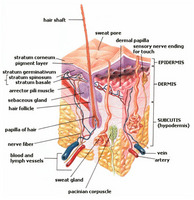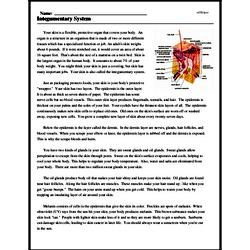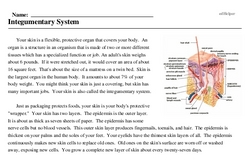Integumentary System
Your skin is a flexible, protective organ that covers your body. An organ is a structure in an organism that is made of two or more different tissues which has a specialized function or job. An adult's skin weighs about 6 pounds. If it were stretched out, it would cover an area of about 16 square feet. That's about the size of a mattress on a twin bed. Skin is the largest organ in the human body. It amounts to about 7% of your body weight. You might think your skin is just a covering, but skin has many important jobs. Your skin is also called the integumentary system.
Just as packaging protects foods, your skin is your body's protective "wrapper." Your skin has two layers. The epidermis is the outer layer. It is about as thick as seven sheets of paper. The epidermis has some nerve cells but no blood vessels. This outer skin layer produces fingernails, toenails, and hair. The epidermis is thickest on your palms and the soles of your feet. Your eyelids have the thinnest skin layers of all. The epidermis continuously makes new skin cells to replace old ones. Old ones on the skin's surface are worn off or washed away, exposing new cells. You grow a complete new layer of skin about every twenty-seven days.
Below the epidermis is the layer called the dermis. In the dermis layer are nerves, glands, hair follicles, and blood vessels. When you scrape your elbow or knee, the epidermis layer is rubbed off and the dermis is exposed. This is why the scrape bleeds and hurts.




